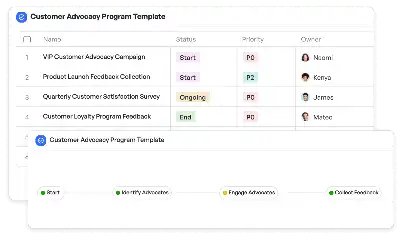Hardware Feedback Taxonomy Model
Achieve project success with the Hardware Feedback Taxonomy Model today!

What is Hardware Feedback Taxonomy Model?
The Hardware Feedback Taxonomy Model is a structured framework designed to categorize and analyze feedback related to hardware products. This model is essential for industries that rely on hardware development, such as consumer electronics, manufacturing, and IoT devices. By organizing feedback into a taxonomy, teams can identify patterns, prioritize issues, and make data-driven decisions. For example, a company launching a new smartphone can use this model to categorize user feedback into performance, design, and usability, ensuring that critical issues are addressed promptly. The Hardware Feedback Taxonomy Model is particularly valuable in scenarios where feedback is diverse and voluminous, providing a systematic approach to manage and utilize this data effectively.
Try this template now
Who is this Hardware Feedback Taxonomy Model Template for?
This template is ideal for product managers, quality assurance teams, and customer support professionals in hardware-focused industries. It is particularly useful for teams handling large volumes of feedback from diverse sources, such as customer reviews, support tickets, and field reports. For instance, a quality assurance team in a manufacturing company can use this model to categorize and analyze defect reports, while a product manager in a consumer electronics firm can prioritize feature requests based on user feedback. The Hardware Feedback Taxonomy Model is also beneficial for startups and small businesses looking to establish a structured feedback management process without investing in complex tools.

Try this template now
Why use this Hardware Feedback Taxonomy Model?
The Hardware Feedback Taxonomy Model addresses specific pain points in hardware feedback management, such as the difficulty of categorizing diverse feedback, identifying actionable insights, and aligning feedback with product development goals. For example, in the context of IoT devices, feedback often includes technical issues, user experience concerns, and feature requests. This model provides a clear structure to categorize and analyze this feedback, enabling teams to focus on high-impact areas. Additionally, it helps in tracking recurring issues, ensuring that critical problems are not overlooked. By using this model, teams can transform raw feedback into actionable insights, driving continuous improvement in hardware products.

Try this template now
Get Started with the Hardware Feedback Taxonomy Model
Follow these simple steps to get started with Meegle templates:
1. Click 'Get this Free Template Now' to sign up for Meegle.
2. After signing up, you will be redirected to the Hardware Feedback Taxonomy Model. Click 'Use this Template' to create a version of this template in your workspace.
3. Customize the workflow and fields of the template to suit your specific needs.
4. Start using the template and experience the full potential of Meegle!
Try this template now
Free forever for teams up to 20!
The world’s #1 visualized project management tool
Powered by the next gen visual workflow engine




